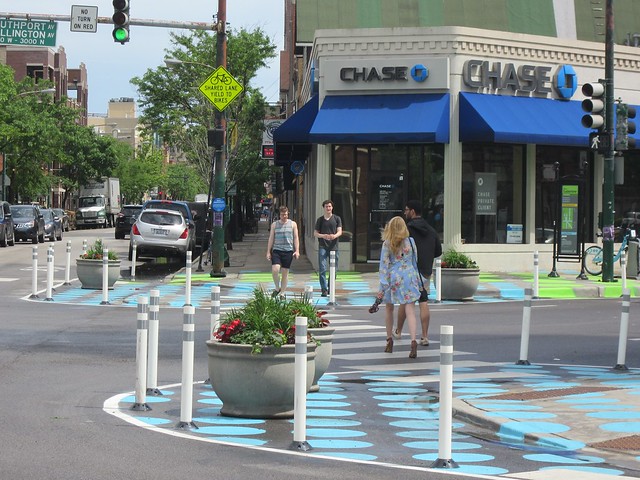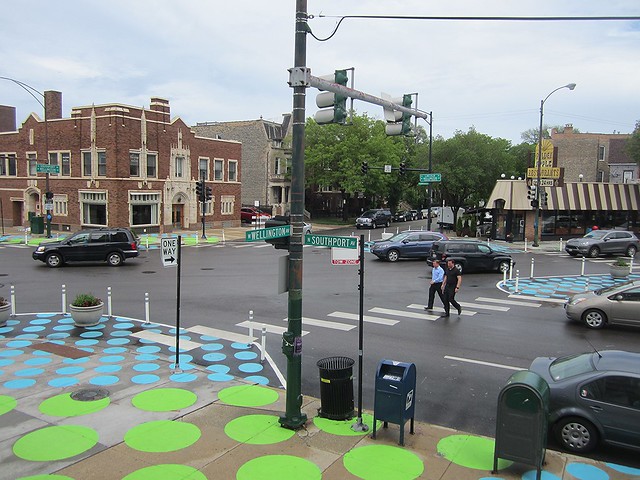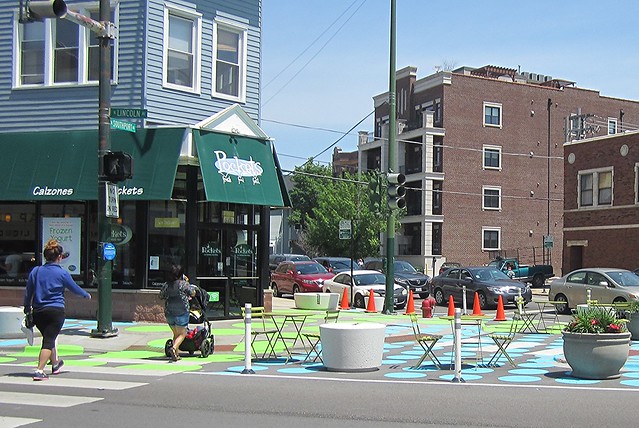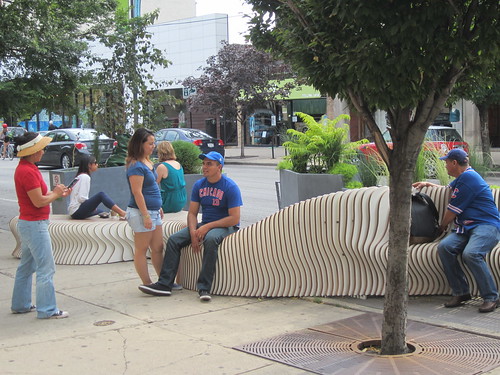Et tu Blair?
It wasn’t surprising when some disgruntled Lakeview residents launched a petition against the Lincoln Hub placemaking project, which reclaimed asphalt at the Lincoln/Wellington/Southport intersection for pedestrians. After all, one purpose of the street remix was to increase safety by slowing down car traffic, and not all drivers are going to appreciate that. And, sure, the bright green-and-blue polka dots are not everyone’s cup of tea.
But it was distressing to read a recent column by Tribune architecture critic Blair Kamin – who’s usually on the right page about urban planning issues – in which he picks apart several aspects of the design and laments that the new layout inconveniences motorists. “The aim of such projects is to ‘calm’ traffic, slowing vehicles and making conditions safer for cyclists and people on foot,” he writes. “It also aims to boost business by creating more inviting outdoor spaces. Yet this mission is far from accomplished.”
Kamin doesn’t have a problem with the colorful spots, and he notes that people on foot like the fact that they've been given more space through the use of paint, flexible posts, and planters, which shortens the crossing distance. He also concedes that, by slowing down drivers, the Lincoln Hub has enhanced traffic safety at the intersection, and may be helping turn the location into a place to spend time, rather than just pass through.
However, Kamin doesn’t like the fact that most of the seating in the new plazas is provided by round concrete stools rather than benches, which he thinks would be more comfortable. He laments the lack of shade at the intersection. And he argues that the on-street seating is located too close to traffic lanes, and there isn’t enough physical protection to make people feel safe using it.
There’s some validity to these criticisms, but it was disappointing to read this passage from a guy who’s supposed to be a well-informed urbanist:
By gobbling up space once occupied by right-hand turn lanes along the curbs [to create pedestrian space], the project forces drivers to make looping turns through the center of the intersection. Frustrated motorists honk their horns, an ironic outcome for a project devoted to "traffic calming."
Kamin is referring to the elimination of the intersection’s slip lanes, aka channelized right turns, which have been incorporated into the curb extensions. That’s actually one of the best things about the Lincoln Hub. Slip lanes create longer crossing distances and additional conflict points between pedestrians and drivers, and they allow motorists to whip around corners at dangerous speeds.
Because of this, the Chicago Department of Transportation is generally no longer building slip lanes, and most six-way intersections in the city aren’t channelized. Rather than creating an aggravation for drivers, removing the slip lanes simply brought Lincoln/Wellington/Southport up to current standards for pedestrian safety.
I’ve hung out at the Lincoln Hub plenty of times and haven’t noticed an unusual amount of honking, but I have talked to residents who appreciate the change, and I’ve seen plenty of people using the seating areas. “This is a project where we’re bringing more foot traffic and creating a more welcoming place,” said Lee Crandell, director of the Lakeview Chamber of Commerce, which spearheaded the $175,000 project. “We didn’t expect it to be an instant transformation, but we are satisfied with the amount of use the space is getting.”
Although sightline requirements prevent the addition of shade trees or café umbrellas at the intersection, Crandell doesn’t see that as a problem. He notes that it’s good to have a mix of sunny and shaded seating in a business district, and just southeast of the Hub on in front of Heritage Bicycles is a “People Spot” mini-park, which gets shade from nearby trees.
While the on-street seating at the Hub is generally sheltered from traffic by large concrete planters, Crandell agrees with Kamin that additional physical protection would help more people feel comfortable using the plazas. The chamber will be adding additional planters along Lincoln later in the summer, and they’ll look into adding more barriers at the plazas as part of that phase, Crandell said.
He feels Kamin was a bit harsh in his judgment of the Lincoln Hub. “Our goal has always been for this to be a temporary, flexible solution that we can adjust to respond to needs,” he said. In the future, the chamber hopes that the paint and flexible posts can be replaced with permanent infrastructure as part of a large-scale, city-funded streetscaping project.
The ironic thing about Kamin’s criticism of the Lincoln Hub is that he followed it up with a solid piece on the sluggish pace of Chicago’s People Spot program, which also repurposes street space to create seating areas. The critic correctly notes that it’s embarrassing that San Francisco, with less than a third of Chicago’s population, has over 50 of these kind of parklets, while Chicago has only six on the street right now. Two other local mini-parks, previously set up in Andersonville, have not yet been reinstalled this year.
Kamin does a good job of laying out reasons why parklets haven’t really caught on here yet. The Chicago winter requires them to be removed and replaced each year, which is expensive. The hated parking meter contract makes it tricky to swap metered spaces for seating. The city government doesn’t pay for the People Spots, which have cost as much as $75,000, leaving it up to local chambers and merchants to come up with funding. Chicago also provides relatively little technical support compared to San Francisco, which created a 76-page how-to manual.
In his People Spot piece, Kamin writes that he’s “jazzed” about transforming space for cars being into places “where people could sit, eat, check their mobile phones and watch the world go by” and rightly complains that this isn’t happening fast enough in Chicago. If that’s how he really feels, it was wrongheaded of him to slam the Lakeview chamber’s efforts to do just that.








